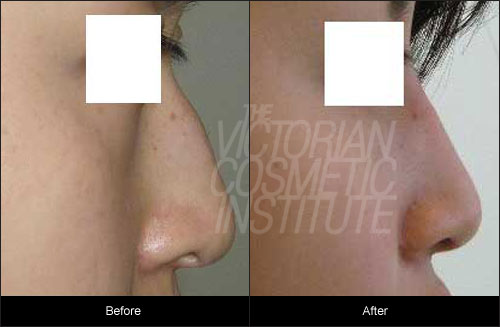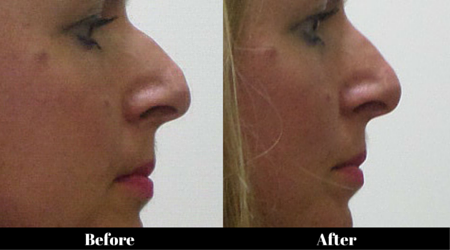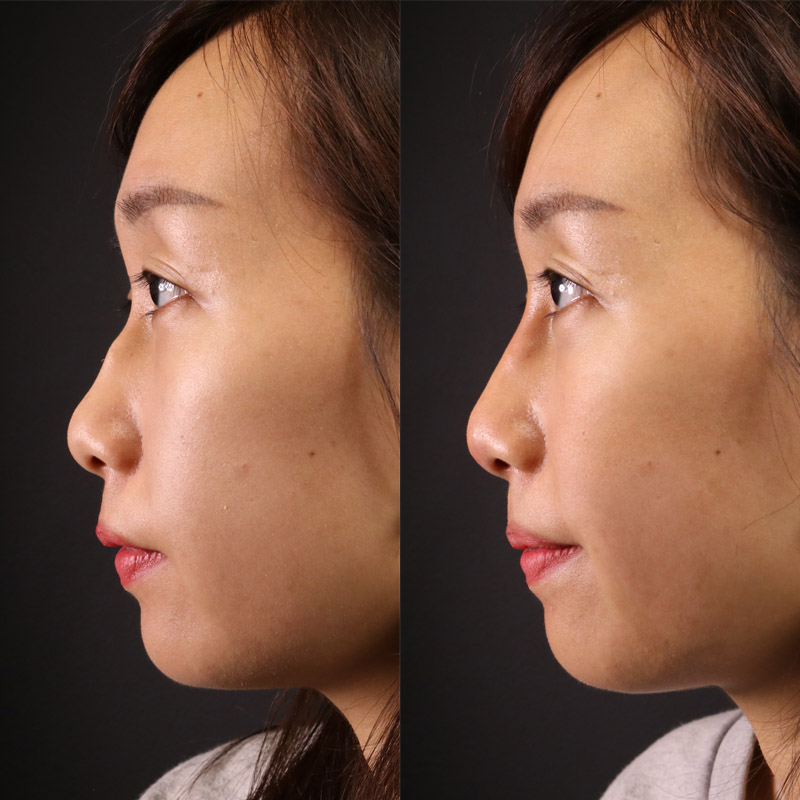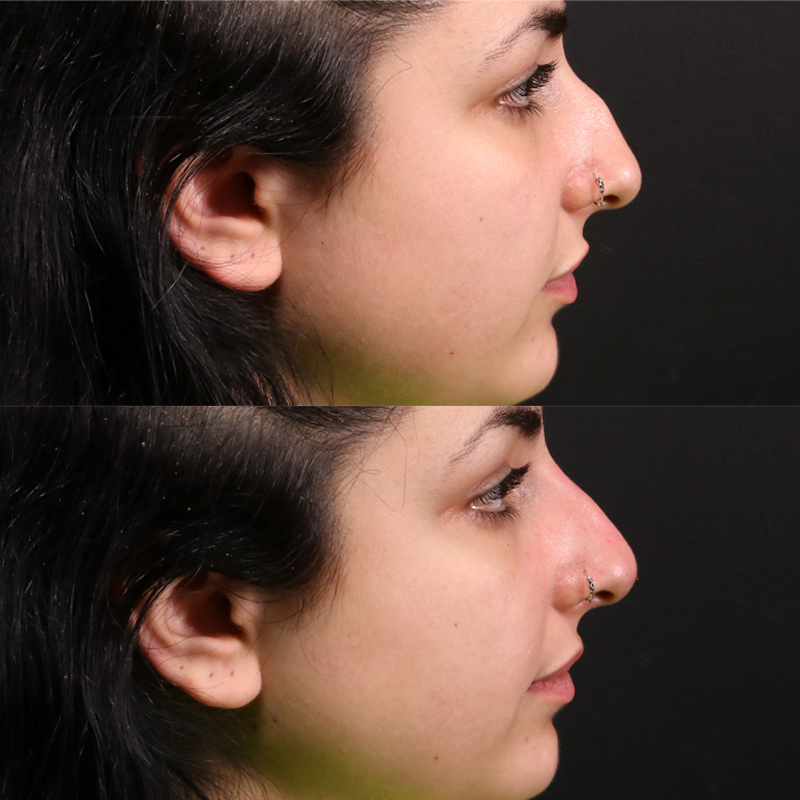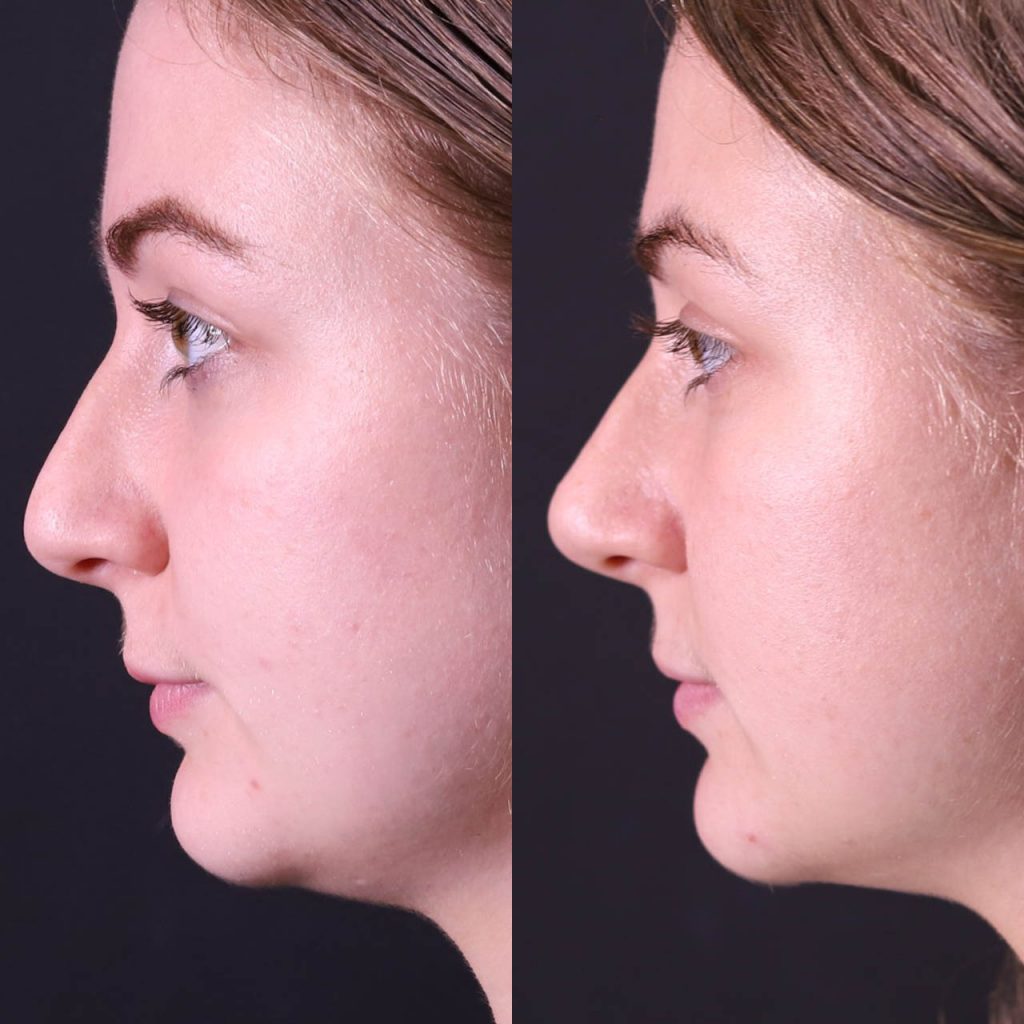Dermal filler treatment to the nose is no longer provided at VCI. The below is for information purposes only.
Last Updated February 2022
Surgery can be a daunting proposition for those wanting to make a change to their nose. Especially given the permanent nature of the procedure, and the relatively high revision rates.
A ‘nose job’ is the colloquial term for surgical rhinoplasty, whereas a ‘liquid nose job’ refers to a non-surgical rhinoplasty performed with dermal fillers. Nose filler is for those considering less invasive alterations for their nose who are possibly not ready for surgery, and would like something temporary and reversible, or even for correction of problems such as divots that may occur after surgical rhinoplasty.
Reversible or dissolvable hyaluronic acid fillers are mostly used, although permanent fillers are also used at times. At Victorian Cosmetic Institute we do not use permanent fillers.
What is a non-surgical rhinoplasty with nose filler?
Traditionally, altering the nose has been done surgically with rhinoplasty. It remains the gold standard for the vast majority, although it is the most invasive and permanent option. For those who do not want a permanent change, or those who would like to try a temporary procedure prior to rhinoplasty, injectable nose treatment with dermal fillers may be appropriate.
Rhinoplasty surgery may be utilised to remove cartilage or bone to straighten or alter the nose shape. Fillers, however, work in reverse to this by filling in hollows, indentations or concavities on the nose.
Bumps or protrusions cannot be removed with dermal fillers. Rather, hollows can be filled in to straighten the nose. For example, if there is a prominent dorsal hump (a bump in the nose or a hooked nose), then the area above and below the hump can be filled to straighten the nose. Another use of nose fillers is to straighten a nose when it deviates to one side. This can be achieved by injecting the concave side of the nose.
Nasal tip elevation is often desired by patients, and can be achieved to a limited degree with dermal fillers. By injecting the tip of the nose, as well as by injecting filler in the base of the columella (the underside of the nose) to lower it, the tip can be made to appear elevated.
Another use of dermal fillers in the nose is to raise the height of the nose in those with less prominent nasal bridges or flatter noses generally. This treatment is popular in the Asian population who tend to have less prominent noses and desire a higher nose bridge. Lifting the nose is limited due to the soft nature of dermal fillers.
Finally, nose filler can also be performed on those who have previously had surgical rhinoplasty and have been left with a small indentation or divot. Filler can be used to fill in the divot and possibly avoid or delay surgical revision that may require a cartilage graft.
What can nose filler correct?
A non surgical nose job can help to correct a number of mild to moderate imperfections, including:
- A dorsal hump (a pronounced bump on the bridge of the nose)
- Ski slope nose
- Button nose
- Mildly crooked nose
- A retracted columella (slightly pulled in nose)
- Droopy nasal tip
Non surgical nose jobs can also help to improve the general shape of your nose, including the height, width and projection. Nose filler may not be able to help if the bump is too extreme or if the candidate has had their nose broken.
Why choose a non-surgical rhinoplasty?
A non-surgical rhinoplasty has a number of benefits that set it apart from a surgical procedure. These include:
- Very little downtime
- Minimal pain and swelling
- Immediately visible results
- No incisions required
When performed by an experienced doctor, a non-surgical rhinoplasty can correct minor bumps or downturned noses at a more affordable price than a surgical nose job.
| Treatment | Effectiveness | Recovery period | Number of treatments required | Cost | Risk |
| Nose Filler | ++ | ++ | Every 1 to 2 years | ++ | ++ |
| Surgical Rhinoplasty | ++++ | ++++ | Once | ++++ | ++ |
Pros and cons of nose filler
Pros of nose filler
- Minimally invasive
- Less downtime than surgery
- Less costly than surgery
- Can be done in clinic
- No general anaesthetic required
- Reversible with hyaluronidase
- May last a long time
- Can transition to surgery afterwards
Cons of nose filler
- Only subtle changes
- Can only ‘add’ and not ‘subtract’ from nose
- Cannot make a nose slimmer or less tall
- Not very effective for nasal tip elevation or for increasing height of nose in general
- Cannot address underlying breathing issues
- Very rarely can cause blindness
- May accumulate if injected too frequently
What are the types of dermal fillers that can be used in the nose?
Hyaluronic acid fillers, which are the most common type of dermal fillers used in general, are the most common fillers used in the nose. They are temporary, but can last a number of years. They are also reversible with an injection of the enzyme hyaluronidase, which dissolves hyaluronic acid fillers. This might be utilised should there be a concern with the aesthetic look of the filler or in emergency situations where filler has been inadvertently injected into an artery.
Permanent fillers can also be used in the nose. The advantage of using permanent fillers in the nose is that the treatment is once-off, and the risk of repeated injections is avoided. The disadvantage is that should placement be sub-optimal, it cannot easily be corrected. Furthermore, permanent fillers do have a greater risk of problems such as granuloma (reactions with the body) causing lumps or hardness of the filler. We do not use permanent fillers at Victorian Cosmetic Institute.
How long does nose filler last?
Hyaluronic acid fillers are temporary and are commonly believed to last from 6 to 18 months after injection into the face. However, on MRI scans, nose filler and filler, in general, have been seen to last a number of years. The MRI pictured shows the presence of filler (white material) after 8 years.
Ironically, many patients do find the effect from nose filler to ‘disappear’ in months and sometimes even weeks. Often filler is ‘firmer’ when first injected. Once settled and integrated into the tissues, the filler may appear less obvious, as the initial lifting effect wanes. This is often mistaken for filler being metabolised.
MRI scans may show the presence of filler despite a loss of the initial effect. For this reason, we generally do not recommend nose fillers to be repeated too frequently, as filler may accumulate in the nose. If a long-term solution is required, then surgery should be considered.
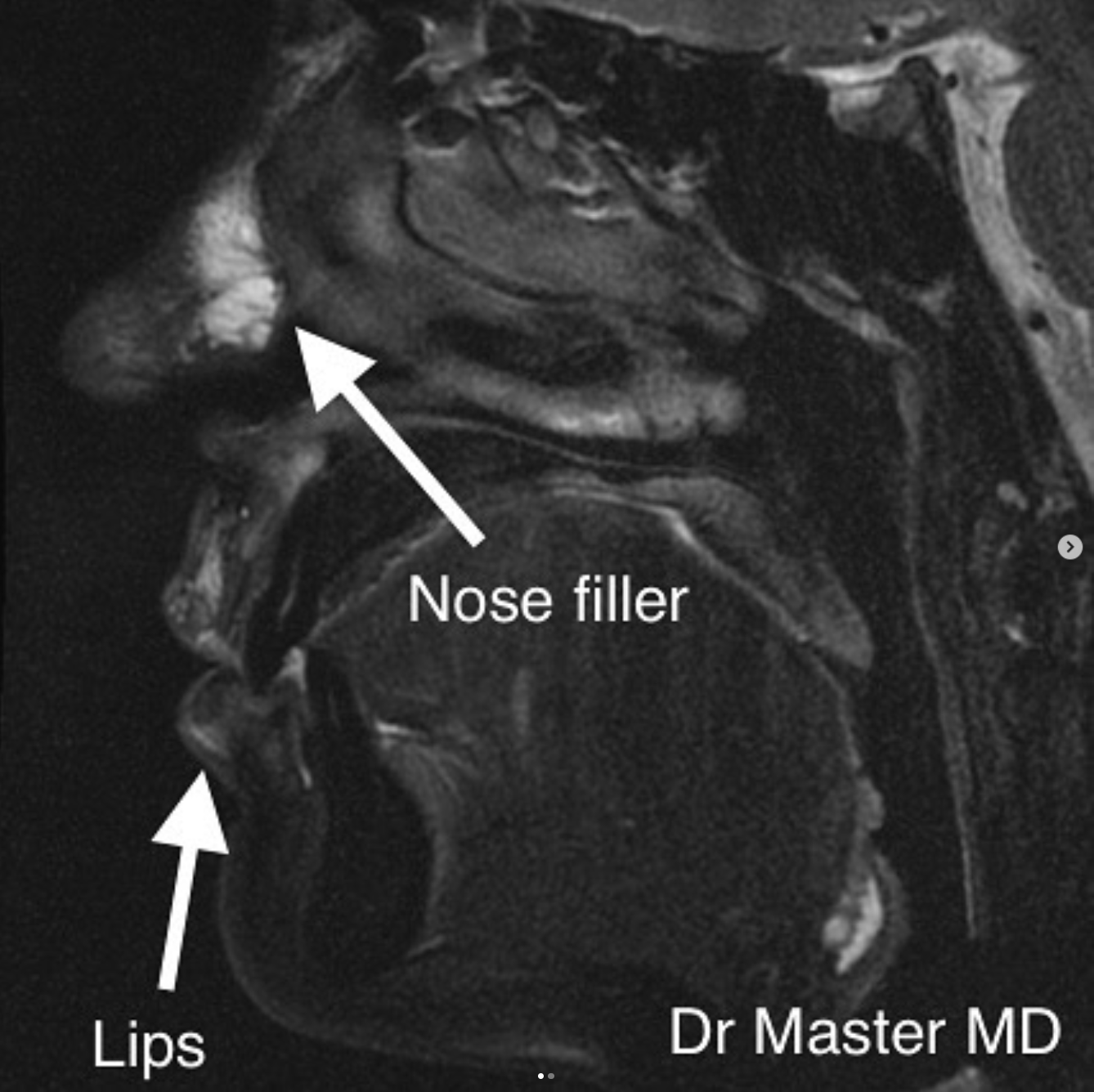
Nose filler on MRI. Credit: Dr. Mobin Master
Who is a suitable candidate for nose filler?
Nose filler can address concerns about mild to moderate flaws and can be used to:
- Make the nose slightly straighter
- Subtly lift the nasal tip
- Create a smoother, straighter profile and even out the appearance of a bump
- Lift the nasal bridge
- Soften sharp angles
- Repair a dent in the nose bridge
- Contour the nose
If you’re considering getting a non-surgical rhinoplasty, the best course of action is to book a consultation to discuss your individual needs and assess whether or not you are a good candidate.
How do I prepare for non-surgical rhinoplasty?
You should avoid taking blood thinning medication such as Aspirin or Ibuprofen for a week prior to the appointment. You should also avoid drinking alcohol for 2-3 days beforehand. These are both to prevent excessive bruising.
Arrive to your appointment with a clean face and no makeup on and make sure you get a good sleep the night before. You should also eat a small meal beforehand and make sure you’re hydrated.
What can I expect during the procedure?
The procedure for nose filler is much faster and more convenient than a surgical rhinoplasty. You will be asked to lie down face up and the doctor may apply a local anaesthetic. The doctor will then inject the filler. You might feel a slight pinch or pressure as the needle goes in but it shouldn’t be more painful than that.
The entire process will typically take less than 30 minutes.
What is the recovery and aftercare process like?
There is no downtime associated with nose filler procedures, so you can immediately return to regular daily activities, with some exceptions.
After your appointment you should avoid any vigorous activity or excessive alcohol consumption for 24 hours. You should also avoid hot environments such as saunas or spas for at least 48 hours.
Avoid touching the area or applying any pressure while it is healing. You can apply makeup after 12 hours. You may wish to take Arnica tablets to reduce some of the bruising.
If you experience severe swelling or pain or any other unusual symptoms, you should call the clinic where you received your injections.
What are the risks of non-surgical rhinoplasty?
One of the risks to be aware of when having nose filler is the risk of vascular occlusion. Although rare, it is possible for filler to be inadvertently injected directly into the arteries in the nose. This may cause a disruption to the blood supply of the nose and surrounding tissues, leading to necrosis or death of the skin of the nose or surrounding areas. Over-injection of filler into the nose may cause compression of the local blood supply (the space in the nose becomes too tight), which can also lead to similar problems.
There is also a rare risk of blindness as a result of filler injections in the nose. One of the arteries supplying the nose is the dorsal nasal artery, which has direct connections with the ophthalmic artery that supplies the retina. Direct injection into this artery with enough volume and pressure can cause blindness by obstructing blood flow in the ophthalmic artery and its branches. To date, there has been at least one case of blindness from filler in Australia, and approximately 200 cases worldwide. Of these cases, nose filler remains one of the more risky areas of the face to inject, with more than half of the cases of blindness occurring as a result of nose filler.
The risks of nose filler generally increase in those who have previously had a traditional surgical rhinoplasty. Surgery causes scarring that fixates blood vessels making them more likely to be entered with a needle or cannula. The presence of scarring also decreases the space within the nose for filler injection making it easier to obstruct blood flow to the nose through vascular compression from fillers.
To avoid the above risk, when possible, we mostly use blunt cannulas rather than needles, as cannulae are less likely to directly enter the blood vessels than a sharp needle. Our practitioners are also conservative in their approach, limiting the amount of volume of filler injected as well as the speed at which the filler is injected. These factors help to reduce the potentially disastrous, although rare, risk of blindness from nose fillers.
Can nose filler be removed or reversed?
One of the properties of hyaluronic acid filler is that they are reversible with an injection of the enzyme hyaluronidase. This might be utilised should there be an aesthetic concern with the filler or in emergency situations where filler has been inadvertently injected into an artery.
How much filler is used in the nose and what is the cost?
The risks of nose filler increase with increasing volumes of filler injected. Although it is possible to inject 1mL or more at a time, we do generally advise only smaller volumes to be injected. This may be as little as 0.2mL in total for example.
It is worthwhile considering using a 1mL of filler for the whole face instead, only utilising a small proportion of this in the nose. This may help to achieve better facial proportion and balance whilst simultaneously reducing the risk of larger amounts being injected into the nose.
For a guide to costs, click on our consultation and procedures pricing page.
FAQ
How does a non-surgical rhinoplasty work?
A non-surgical nose job works by carefully and accurately placing dermal fillers in the nose in order to correct minor bumps and indentations.
What is nose filler made of?
It is usually made of hyaluronic acid, which is a naturally occurring substance in your body.
Are nose fillers permanent?
No, hyaluronic acid fillers can be reversed using an enzyme called hyalase. The reversal will be immediate.
How much does a non-surgical nose job cost in Australia?
The pricing of a non-surgical nose job will depend on the amount of filler that you need. The doctor will assess this in your initial consultation.
Visit our pricing page for a general list of costs.
How long does a non-surgical nose job last?
Nose filler generally lasts longer than fillers in other areas of the face (such as the lips) because it is a low movement area. Hyaluronic acid will metabolise at different speeds depending on lifestyle factors such as smoking and exercise levels, but in most people nose dermal filler will last for 12-18 months.
Can nose filler lift the tip of the nose?
Yes, nose filler can be used to lift the nasal tip. It can be a good alternative to surgery.
Can nose filler improve a droopy tip?
Nose filler treatment can be used to lift the tip, but may not be able to produce the same dramatic results as surgery. Nose dermal filler injections can be combined with muscle relaxant injection to lift the nasal tip more effectively.
How long does it take for nose filler to settle?
Visible swelling should go down within 2-3 days, but it may take up to 14 days for micro-swelling to subside.
Why should I choose the Victorian Cosmetic Institute as my provider of Non-Surgical Rhinoplasty?
At Victorian Cosmetic Institute, our team of cosmetic doctors and nurses specialise in performing nose dermal filler. We use fillers that are most appropriate for the nose. We understand that this treatment is important to you, and can provide you with an individualised treatment to suit your needs.
To make an appointment to see one of our practitioners, please click on the Book Online button.
Otherwise, you can phone us directly on 1300 863 824.
